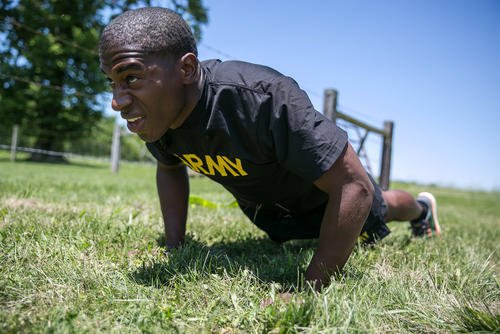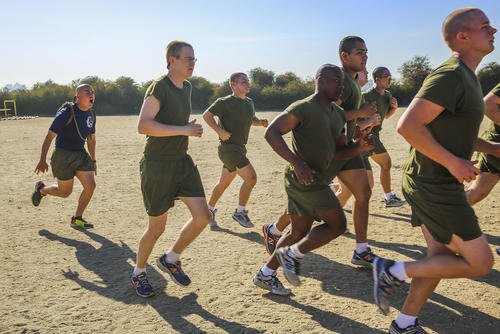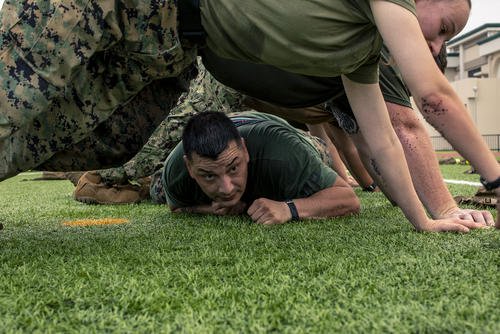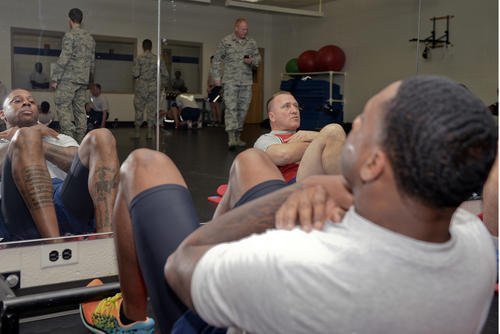Recruits face several goalposts when entering a military program that involves swimming and diving. First, they must pass a fitness test to be accepted for the training and master various pool skills for a typical 500-yard or 500-meter swim.
These candidates include everyone from swimmers to divers, as well as Special Warfare Combatant-Craft Crewmen (SWCC), Navy SEALs, Pararescue Jumpers (PJs) and Recon/MARSOC members.
Building a requisite level of swimming conditioning and water confidence for these programs takes time, patience and consistent time in the water.
Here is how to structure your workouts so you can successfully prepare for these programs:
Warm-Up
I recommend making swimming and treading water part of your warm-up process in the pool. If you have to take a 500-yard swim test, warm-up at that distance. Alternatively, consider a 10-minute tread with no hands as a warm-up if you already achieve above-average results on the 500-yard swim test.
Read Next: How to Improve Your Cardio Fitness Safely
If you have issues with both the swim test distance and treading, use one as your warm-up and one as your cooldown. This way, every time you are in the pool you are practicing these two important skills. You need to prepare for both swim events to pursue your special operations dreams.
Here is how it looks:
- Warm-up: Swim 500 meters or 500 yards or tread with no hands (nonstop) for 10 minutes.
- Repeat 10 times:
- Swim freestyle for 100 meters fast.
- Swim the Combat Swimmer Stroke (CSS), sidestroke or breaststroke for 50 meters at an easy pace.
- Rest by treading, bottom bouncing or floating for one minute.
The above 1,500-meter section is the meat and potatoes of this swim workout. Your goal is to get winded enough to improve cardio fitness with the freestyle set, then follow it with a 50-meter swim to catch your breath. The rest involves pool skills, which can include those seen in events such as the drownproofing test, underwater knot tying or treading tests. This is an active rest that forces the recruit not to blow off these skills, as they will be part of the special ops selection process.
We typically do the above workout on upper-body days and will include pool PT during rest sets.
Swim with Fins on Leg Days
You also need to prepare your legs for longer swims with scuba fins. When you have a leg day, a great way to top it off is with a 30- to 40-minute fin swim. It may take a few weeks to build up enough ankle mobility so that swimming with fins no longer hurts, but it is highly recommended to experience this pain now instead of during any of these military swimming and diving programs.
Use the same warm-up above on the days you swim with fins. Afterward, the workout is 1,500 meters to 2,000 meters (or more) with fins. The goal is to get into a consistent pace of a yard or a meter per second. This pace will put you in good standing with the standards of these military programs.
The cooldown can be a combination of multiple swimming skills. You can do a simulated drownproofing test, tread (no hands) or swim easily if you need more swimming time to focus on technique instead of conditioning. With the above system of pool skills and swimming workouts (both for conditioning and finning) four to five times a week, you will be well-prepared for future military training.
Consider SCUBA Certification
It is never a bad idea to become scuba certified prior to joining the military. Getting comfortable with a regulator in your mouth and breathing underwater for the first time can be overwhelming for some. Companies certified by the Professional Association of Diving Instructors (PADI) or the National Association of Underwater Instructors (NAUI) can help you with getting over that initial anxiety with basic scuba courses.
You can find more swimming workouts and technique instruction at the Military.com Fitness Section.
Want to Learn More About Military Life?
Whether you're thinking of joining the military, looking for fitness and basic training tips, or keeping up with military life and benefits, Military.com has you covered. Subscribe to Military.com to have military news, updates and resources delivered directly to your inbox.


















